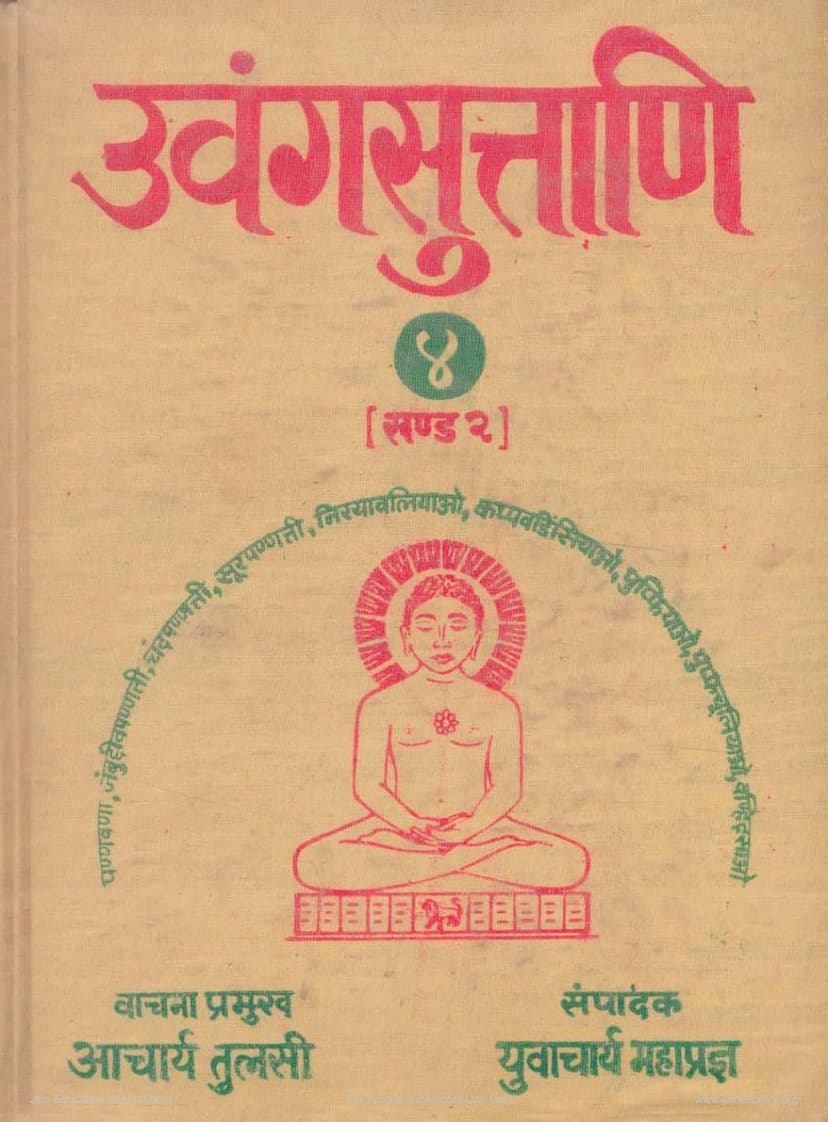Agam 16 Upang 05 Surya Pragnapti Sutra Surpannatti Terapanth
Added to library: September 1, 2025

Summary
The Agam 16 Upang 05 Surya Pragnapti Sutra Surpannatti, published by Jain Vishva Bharati, is a significant text within Jain literature, critically edited and presented by Acharya Tulsi and Yuvaacharya Mahapragna. This compilation, forming Part IV of the "Uvangasuttani" series (Volume II), contains nine Upanga Sutras:
- Paṇṇavaṇā (Prajñāpanā)
- Jambuddivapaṇṇatti (Jambūdvīpaprajñapti)
- Candapaṇṇatti (Candraprajñapti)
- Sūrapaṇṇatti (Sūraprajñapti)
- Nirayāvaliẏao (Nirayāvaliẏao)
- Kappavāḍimśiyāo (Kappavāḍimśiyāo)
- Puṣphiẏao (Puṣphiẏao)
- Puṣphacūlīyāo (Puṣphacūlīyāo)
- Vanhidāśāo (Vanhidāśāo)
This volume marks the completion of the publication of all 32 Jain Agamas in the "Agam-Sūtra Granthamala" series, which began with the Angasutras and has continued with the Upangas and other texts. The project, initiated by Acharya Tulsi on Mahavira Jayanti in 1955 AD, involved meticulous research, textual criticism, and compilation by numerous monks and nuns under the guidance of Acharya Tulsi and the primary editorship of Yuvaacharya Mahapragna.
Key Features and Content:
-
Comprehensive Coverage: The book presents the original Prakrit text of these nine Upangas, critically edited with variant readings.
-
Editorial Rigor: The text has been compiled and edited with great scholarly effort, drawing from multiple manuscript sources and commentaries, aiming for accuracy and authenticity.
-
Subject Matter:
- Paṇṇavaṇā: Focuses on the detailed exposition of the two fundamental substances of Jainism: Jiva (sentient soul) and Ajiva (insentient matter). It delves into their various classifications and characteristics, including unique concepts like the "common-bodied" (sādhāraṇaśarīrī) beings, which offer a perspective on collectivism. It is considered a foundational text for Tattva-vidya (Science of Reality).
- Jambuddivapaṇṇatti: Primarily deals with the geography and cosmology of Jambūdvīpa, a central continent in Jain cosmology. It describes the Kalachakra (Wheel of Time), the lives of Lord Rishabha and Bharata Chakravarti, and offers detailed accounts of celestial bodies and the structure of the universe.
- Candrapaṇṇatti & Sūrapaṇṇatti: These texts are astronomical in nature, focusing on the movements, characteristics, and significance of the Moon (Chandra) and the Sun (Surya) respectively. They discuss their celestial paths, cycles, and influence.
- Nirayāvaliẏao and the following four texts (Kappavāḍimśiyāo, Puṣphiẏao, Puṣphacūlīyāo, Vanhidāśāo): These texts are generally categorized as dealing with narratives, historical events, disciplinary rules, and the results of actions (karma-vipāka). They often narrate stories of righteous individuals, kingly conduct, renunciation, and the consequences of good and bad deeds. For instance, Nirayāvaliẏao is described as dealing with auspicious and inauspicious conduct, karma, and their results, with the first section detailing a significant battle.
-
Historical Context: The introduction provides valuable information about the historical context of Jain Agamas, including their classification, the challenges of manuscript editing, and the philosophical nuances of ancient texts. It highlights the efforts undertaken since 1955 AD to bring out these critical editions, emphasizing the dedication of Acharya Tulsi and the entire Jain Vishva Bharati institution.
-
Commentaries: The text acknowledges the existence of numerous commentaries on these Agamas, with notable mentions of works by Hari-bhadra Sūri, Abhayadeva Sūri, and Malayagiri.
-
Comprehensive Project: The publication of these 32 Agamas represents a monumental achievement in Jainological studies, providing scholars and practitioners with access to these foundational scriptures in a critically edited format.
The preface and editorial sections express deep gratitude to the supporters and collaborators who made this extensive publication project possible, underscoring the importance of preserving and disseminating Jain knowledge. The work is dedicated to the "Niggantham Pāvayanam" (The Liberated Teaching).